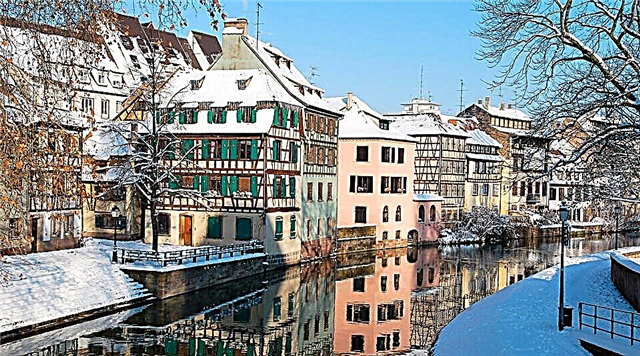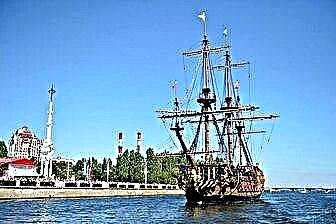Voronezh is worth visiting not only for its interesting museums, numerous parks and picturesque squares. There are also funny monuments to animals - heroes of famous literary works, and monuments-copies of the first Peter's ships. As well as unusual buildings in the Art Nouveau and Gothic style of the late XIX-XX centuries, which is quite surprising for a city located in the south of Central Russia.
There are many traditional Russian churches, theaters, and former merchant mansions in Voronezh that catch the eye with their noble and elegant appearance. Also, tourists should pay attention to the monuments perpetuating the image of the heroes of the Great Patriotic War. The Voronezh Sea, a huge urban reservoir stretching for tens of kilometers, is of no less interest.

The best hotels and hotels at affordable prices.
from 500 rubles / day
What to see and where to go in Voronezh?
The most interesting and beautiful places for walking. Photos and a short description.
Monument to White Bim
One of the unofficial symbols of the city, created by sculptors I. Dikunov and E. Pak based on the work of the same name. It is interesting that the craftsmen made it exclusively at their own expense. The statue is a figure of a dog sitting right on a pavement and patiently awaiting the return of its owner. The monument was erected in 1998 on Revolutsii Avenue near the Jester puppet theater.

Kitten from Lizyukov street
A monument that immortalized another popular hero - a kitten from a Soviet cartoon, who, according to the plot, was an inhabitant of Voronezh. The sculpture was created by I. Dikunov and E. Pak in 2003. The author of the idea was a student of the 11th grade who won the competition for the best projects. The figure of an animal sits on a tree branch. It seems that the kitten is completely engaged in a conversation with a curious crow.

Ship-museum "Goto-Predestination"
A copy of a real ship from the time of Peter I, standing at the Admiralteyskaya Square. The idea to create a museum ship came to the head of the Voronezh authorities in 2009. At first, it was assumed that specialists from Denmark would work on it, but in the end the structure was erected by Russian craftsmen. The museum was inaugurated in 2014 on Navy Day. Its exposition consists of objects that tell about the origin and development of the navy.

Admiralteyskaya Square
The square is located in the center of Voronezh within the Petrovskaya embankment. It was built in 1996 to commemorate the 300th anniversary of the Russian fleet. The architectural dominant feature of the site is a high rostral column. The ensemble also includes the Assumption Admiralty Church of the 17th century. Admiralteyskaya Square often becomes a venue for concerts and mass festivities.

Square of victory
One of the central squares of Voronezh, where the memorial complex in honor of the defenders of the city is located. Its opening took place in 1975 on the occasion of the 30th anniversary of the Victory. A monumental monument of red granite and metal is located at the northern tip. It consists of 12 figures depicting all branches of the Soviet Army, as well as partisans and militias. Before the silently frozen statues, the Eternal Flame burns.

Blagoveshchensky cathedral
The city's cathedral, built in the picturesque Russian-Byzantine style, designed by V.P. Shevelev. The cathedral was built in the period 1998-2009. Its opening was accompanied by a procession of the cross and large-scale events, in which many residents of the city took part. Today the temple is an important religious center with regular services and a Sunday school.

Uspensky Admiralty temple
The oldest church in the city that has survived to this day. It was erected in the 17th century (or at the end of the 16th), after which it was repeatedly renovated and rebuilt. The predominant architectural style of construction is classicism. In the 1930s, the temple was closed, and during the Second World War it was destroyed due to bombing. Since the 1970s, separate restoration work has been carried out, but a full-fledged reconstruction was carried out only in the 2000s.

Alekseevo-Akatov Monastery
The women's monastery, which emerged in the 17th century. Initially, the monastery was for men, but after the revival in the 20th century, nuns began to live here. The complex was built in the Russian-Byzantine style; during the restoration, the masters tried to recreate its original forms. Here are kept the miraculous icon "Life-giving source" and the healing image of the great martyr Panteleimon.

Cathedral of the Intercession
The first wooden church on the site of the Intercession Cathedral was erected at the beginning of the 17th century, the stone church appeared many years later - at the end of the 18th century. In 1833-41 it was rebuilt in the classical style according to the project of the architect I. A. Blitsyn. In Soviet times, the building housed various institutions, including the local museum of local lore, thanks to which the cathedral managed to survive.

A. V. Koltsov Drama Theater
One of the oldest theaters in Russia, founded in 1802. His first troupe consisted of freed peasants (former serf actors) and ordinary enthusiasts. A separate building for the stage was built in 1821, in 1886 it was rebuilt in the pseudo-Russian style. Unfortunately, it has not survived to this day, as it was destroyed during the Second World War. The modern building adorned the city in 1944.

Opera and Ballet Theatre
The main musical stage of Voronezh, which first appeared in the city in the 1930s on the basis of the Musical Comedy Theater. For a long time of work, more than 200 works from the classical ballet and opera repertoire have been staged here. The team went on tour in Europe, Asia and America, which speaks of the high professionalism of the actors. Today the theater program consists of both traditional works and contemporary works by talented authors.

Puppet theater "Jester"
The history of the puppet theater began in 1925 with an amateur university production, in which young artists were involved. Very soon, the performances moved to a professional platform, and the stage gained popularity among the audience. The theater's repertoire is composed of works for adults and children. Plays by N. Gogol, M. de Cervantes, W. Shakespeare, A. Chekhov, R. Kipling and other famous authors are staged here.

Voronezh Museum of Local Lore
The museum is renowned as one of the leading exhibitions in the city. It houses numismatic, ethnographic, philatelic, weapons collections, as well as collections of porcelain, ceramics, rare books and other valuable exhibits. The main building of the museum is a picturesque urban mansion from the beginning of the 20th century with a bright red facade. The building was built of bricks in the eclectic manner, diluted with elements of the Russian style.

The building of the bourgeois council
An architectural monument of the late 18th century. The building was built in an exemplary classical style, which is quite rare for provincial architecture. Initially, the building was created for the industrialist S. Savostyanov. Since 1870, the Voronezh bourgeois council was located here. Today the mansion occupies one of the subdivisions of the literary museum. I. S. Nikitin.

Art Museum named after I. N. Kramskoy
The museum exposition is located in a baroque palace of the 18th century, built according to the project of N. Ievsky by order of the Voronezh governor. It houses an impressive collection of artifacts from the ancient world, Russian and European painting, sculpture, icons and objects of applied art. The museum was founded in 1933, today it is the largest cultural center of the city and the entire region.

Arsenal Museum
The exposition is located in the building of the former Gardenin cloth factory. The exact date of its construction is not named, but it is believed that it was erected in 1774-77. Since 1910, an arms warehouse was located here. During the Second World War, the shells miraculously did not hit the structure, so it reached us almost in its original form. The collection of the Arsenal Museum consists of exhibits from the Second World War.

"Museum of Forgotten Music"
Perhaps one of the most interesting and unusual exhibitions in Voronezh, which consists of musical instruments of different nations. Some of them are no longer used, while others were specially created based on plots of literary and artistic works. The collection was collected spontaneously - something was obtained by the museum staff, other exhibits were donated by caring people.

Voronezh Oceanarium
The very first oceanarium opened in the Central Federal District in 2011. Its pools and aquariums are home to about 200 species of fish, several dozen marine mammals, as well as reptiles and birds (more than 3500 thousand individuals in total). Some representatives of the oceanic fauna can be seen only here. For example, electric eel, Japanese moray eels and spider crabs, tiger sand shark.

Model of the ship "Mercury"
Monument to the ship "Mercury", launched in the times of Peter the Great. At one time, this frigate led a detachment of five ships, on which the tsar made the Azov campaign. The model is a symbol of Voronezh - "the cradle of the Russian fleet", because it is believed that one of the first shipyards in Russia was located in this city. The monument stands in the middle of the Voronezh reservoir on a concrete pedestal.

A stone bridge
A small bridge 10 meters long, built in 1826 according to the project of I. Blitsin as part of the governor's program for the improvement of the city. It was erected in order to facilitate travel along Staro-Moskovskaya Street. The brick structure was the first building of this type in the city and immediately received the name "Stone Bridge". For the 400th anniversary of Voronezh, the pontoon was repaired and renewed.

Rotunda
Part of the hospital building of the 1930s, destroyed during the Second World War. Today its ruins are a vivid monument to the events of the war. In 1942-43, during the battles for the city, this area several times passed from one opposing side to the other, as a result of which the structure suffered significant damage. After the end of hostilities, there was simply no money to restore the hospital, its brick walls were dismantled for the construction of new residential buildings. As a result, only the concrete frame remained.

South-Eastern Railroad Administration Building
An administrative building built in 1929–32, built in the style of Soviet constructivism. It was damaged during the war, after which it was rebuilt in a pseudo-classical manner. This building is considered one of the most beautiful in Voronezh, it is a symbol of the pre-war era with its inherent gigantomania, the desire for labor feats and a colossal leap in industry.

The building of the hotel "Bristol"
The building is in the Art Nouveau style, built at the beginning of the XX century by the project of the Moscow architect M. Ye. Furmanov. For its time, the building turned out to be innovative, since the creator, being also an engineer, applied various technical innovations during construction. For example, an elevator was installed here for the transportation of passengers and cargo - one of the first structures of this type in the city.

Oldenburgsky Palace (Ramon)
A mansion of the late 19th century, an example of Russian neo-Gothic style - a rather rare style for the Russian province of that time. The house belonged to the Russian branch of the noble family of the Dukes of Oldenburg. The building was built according to the project of H. Neisler by order of Eugenia Maximilianovna Romanovskaya, Duchess of Leuchtenberg. Today, excursions are held in the palace, although restoration work has been going on for more than a decade.

Park "Scarlet Sails"
Park on the shores of the Voronezh reservoir, opened in 1975. By 2011, it was restored according to the project of the landscape designer from France O. Damier, after which it became a real decoration of the city and entered the list of the best parks in Russia. The place is divided into thematic parts: beach, dance floor, space for children, summer theater, cafe, picnic area, recreation areas.

Koltsovsky square
Park on pl. Lenin, one of the popular resting places of the townspeople. There is a light and music fountain and a bust of A. Koltsov, created by the sculptor A. Triscorni. The square appeared in 1871; at the beginning of the 20th century, it became a favorite place for a summer evening promenade. In 2009, after reconstruction, the park was transformed: new lighting was installed and paving slabs were replaced.

Petrovsky square
A small park in the center of the city, named after the monument to Peter I, first erected here in 1860. During the war, the monument was taken out by the German invaders. In 1956, sculptors G. Schultz and N. Gavrilov created a copy of the stolen statue from surviving photographs. Today Petrovsky Square is a popular place for dates and friendly meetings.

Voronezh Central Park
The main and largest park in the city, covering an area of about 100 hectares. Its history began with the creation of a plant nursery in 1844. After the establishment of Soviet power, the significantly expanded botanical garden was transferred to the jurisdiction of the local university. During the Second World War, almost all green spaces were destroyed, so the park had to be rebuilt almost from scratch.

Voronezh reserve
The reserve is located on the territory of the Lipetsk and Voronezh regions, it covers an area of more than 31 thousand hectares. It was formed in 1923 with the aim of preserving the flora and fauna of the forest-steppe zone. Shrews, hares, bats, minks, deer, badgers, burial eagles, desman and several dozen species of animals, birds and amphibians live here.

Voronezh reservoir
One of the world's largest artificial reservoirs located within the city. Its length is about 30 km. The reservoir was created in 1971–72 together with the dam in order to provide Voronezh with water. On its territory there are several uninhabited islands - former highlands. Locals often call the reservoir the "Voronezh Sea" because of its incredible size.












